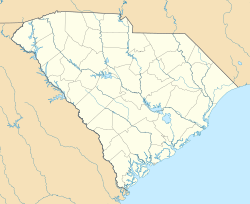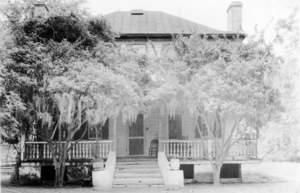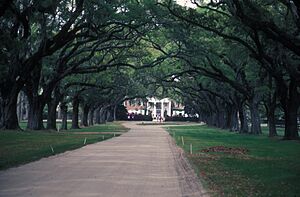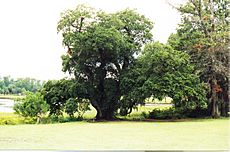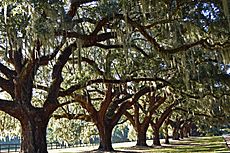Boone Hall facts for kids
|
Boone Hall Plantation
|
|
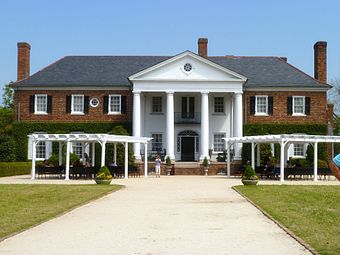
The main house at Boone Hall
|
|
| Location | 1235 Long Point Rd Mount Pleasant, South Carolina |
|---|---|
| Area | 738 acres (298.7 ha) |
| Built | 1936 (reconstruction) 1681 (settled) |
| Architect | William Harmon Beers |
| Architectural style | Colonial Revival |
| NRHP reference No. | 83002187 (original) 93001512 (increase) |
Quick facts for kids Significant dates |
|
| Added to NRHP | July 14, 1983 |
| Boundary increase | January 21, 1994 |
Boone Hall Plantation is a historic place in Mount Pleasant, South Carolina. It is located in Charleston County, South Carolina, in the United States. This plantation is one of the oldest farms in America that is still working today. It has been growing crops for over 320 years.
Most of the work, including building and making bricks, was done by enslaved African Americans. The main house you see today was built much later, in 1936. Because of its important history, Boone Hall was named one of the African American Historic Places in South Carolina in 2009. The site has a 1936 house built in the Colonial Revival style. It also has beautiful features like a long road lined with southern live oak trees. These trees were planted in 1743. Today, you can visit Boone Hall Plantation and take tours.
History of Boone Hall
Early Years and Owners
The first record of Boone Hall is from 1681. The owner, Theophilus Patey, gave 470 acres of land to his daughter Elizabeth. This was a wedding gift for her and her new husband, Major John Boone. Their land became known as Boone Hall Plantation. We do not know exactly when the first house was built there.
John Boone was one of the first people to settle in the South Carolina colony. He arrived in 1672. John Boone and his wife were ancestors of important American leaders. These leaders included Edward Rutledge and John Rutledge.
John Boone was part of the colonial Grand Council in the 1680s. He was removed twice because he traded enslaved Native Americans illegally. He also had connections with pirates and hid stolen goods. However, he also held other local jobs, like tax assessor. When John Boone passed away, he divided his property among his wife and five children. His oldest son, Thomas, made Boone Hall his home. Later, another family member named John Boone owned it.
The Horlbeck Family and Brick Making
The Boone family owned the plantation until 1811. John Boone's widow, Sarah Gibbes Boone, sold the property to Thomas A. Vardell. Soon after, Henry and John Horlbeck bought the plantation. This included the enslaved African Americans who lived there.
The Horlbeck brothers used many of the enslaved workers to make bricks. These workers had previously worked in the fields. In the early 1800s, many landowners in Charleston built and made their houses bigger. They used bricks from plantations like Boone Hall.
Enslaved workers made the bricks by hand. They also built many houses and public places in downtown Charleston. These workers had amazing skills in carpentry, math, and geometry. By 1850, they made 4 million bricks each year. You can still see their fingerprints in the bricks of many old buildings in Charleston.
The Horlbeck family also had enslaved gardeners plant the famous Avenue of Oaks. Each oak tree was planted in 1843 using hand tools. They also had workers plant pecan trees to grow a new crop. By the late 1800s, Boone Hall was a top producer of pecans in the United States.
In 1837, Henry Horlbeck died. His children sold their shares of Boone Hall to four of his sons. This happened on October 1, 1842. The plantation was described as having a "Wooden Dwelling House," "Brick Stables," and "Brick Kilns." It covered 1442 acres.
New Owners and Public Tours
In 1935, Thomas Stone from Canada bought Boone Hall Plantation. The old wooden house on the property did not look like what he imagined a southern plantation house should be. So, Thomas Stone and his wife, Alexandra, tore down the old house. They built a new, modern house in 1936. This new house was designed in the Colonial Revival style.
The Stones focused on growing pecans on 200 acres of the farm. They also built a power plant that used the tides from nearby rivers. This plant provided electricity for the plantation.
In 1940, the Stones sold Boone Hall to Prince Dimitri Jorjadze from Georgia (the country). His wife was Audrey Emery Jorjadze, an American socialite. The prince owned racehorses under the name Boone Hall Stable. His most famous horse was Princequillo. In 1943, Princequillo was the fastest distance runner in the United States. The Jorjadzes sold the plantation in 1945 to Dr. Henry Deas.
Dr. Deas sold it ten years later, in 1955, to Harris M. McRae and his wife Nancy. The McRaes continued farming the land. They changed the main crop to peaches. In 1956, they opened the plantation for public tours.
Boone Hall Today
The McRae family still owns Boone Hall today. They work hard to protect the old buildings and gardens. Because of its role in the history of the South and its surviving brick slave cabins, Boone Hall is an important African American Historic Place in South Carolina.
The Main House and Gardens
The Main House Design
The main house at Boone Hall Plantation is a modern building. It was built in 1936. Thomas Stone hired architect William Harmon Beers to design a larger, modern home. It was built by Cambridge M. Trott. The house sits on the banks of Horlbeck Creek. It faces south and has two and a half stories. It uses materials from old farm buildings and bricks from a historic brickyard.
The front of the house has eight sections. A large porch with a triangular roof is in the middle. Six big columns support this porch. The porch has a round window in its top part. The windows on the first floor are different sizes. The front door has glass panels on the sides and a fan-shaped window above it. The windows on the second floor are a bit shorter. There is an iron balcony above the front door. The roof is sloped and has tall brick chimneys on each side.
On the back of the house, a section with four parts sticks out from the eastern side. This section has a sloped roof with windows that stick out. These windows show that the attic level is finished. There are brick chimneys on the back and east sides of this section. Two smaller parts also stick out from the back. One small brick building was used for farm storage. Another small building was an office. This office building is older than the main house. It was moved and attached to the house.
Behind the house, there is a brick patio. It is surrounded by a wavy brick wall. Doors from the house open onto this patio. The house also has a basement with a cement floor. Brick supports help hold up the main building.
Inside the Main House
The inside of the main house looks like homes from the 1700s. It covers about 10,000 square feet. The main rooms are on the first floor. The entrance hall has smooth walls and a fancy ceiling border. The floor is made of teak wood in a pattern. A winding staircase goes up to the second floor. A tall, arched window lights the staircase.
To the left of the entrance is the library. It has dark wood walls and a white border around the bottom. There is a simple fireplace and bookshelves with glass doors. Fancy French doors in the library open to the patio. To the right of the entrance, an arched opening leads to the dining room. The dining room has wood floors and red wood panels on the walls. It connects to the kitchen through a butler's pantry. The kitchen is large and designed for big parties.
Under the staircase, an arched opening leads to a covered walkway. This walkway connects to the game room. The walkway has a brick ceiling and brick floor. It has a fireplace and three sets of French doors that open to the patio. The game room has wood beams on the ceiling and wood walls. The floor is made of old pine wood. The game room also has a small wine cellar in the basement. The family's private rooms are on the second floor. These rooms are not open for public tours. An elevator goes from the basement to the second floor.
Gardens and Other Buildings
Boone Hall Plantation covers 738 acres. It has fields where crops are grown. It also has protected wetlands, creeks, and ponds.
The most famous part of the grounds is the Avenue of Oaks. This grand road was first planted in 1743. It was finished by the Horlbeck brothers in 1843. The road has 88 live oak trees and one magnolia tree. They are spaced evenly. The road is about three-quarters of a mile long. It goes from the plantation entrance to two brick gateposts. These gateposts have round tops and iron gates. They, along with a wavy brick wall, surround the front yard of the house.
Open grassy areas on each side of the driveway have formal gardens. These gardens have brick paths, large live oaks, and many flowers. In the 1800s, visitors would drive through the tunnel of oaks. They would pass many slave cabins on the left side of the road. The small cabins looked very different from the large house at the end of the drive. This view showed that the place was for work and production, not just for fun.
The first slave cabins were probably made of wood. The brick slave cabins you see today were built between 1790 and 1810. These one-story buildings are 12 feet by 30 feet. They have sloped roofs and simple fireplaces. The cabins were used until the 1940s by sharecroppers. These homes were lived in by enslaved workers and then free sharecroppers for almost 150 years. This makes them very important to the history of the site.
In front of the main house, there are two pergolas. These were built in 1993 to make the gardens even nicer. At the edge of the gardens, there is a brick smokehouse from 1750. It is a round building with a cone-shaped roof.
To the southeast of the main house is a large Cotton Gin house. It was built in the 1850s. The machines for processing cotton are no longer there. This building has been used as a guest house, restaurant, and gift shop. In September 2023, it reopened with a new visitor center. It also has a museum about over 300 years of history. There is a new gift shop and space for events upstairs.
Boone Hall Farms
Boone Hall Plantation also runs a farming business called Boone Hall Farms. In the spring and summer, they grow strawberries. They host a yearly Strawberry Festival where visitors can pick thousands of pounds of strawberries. Boone Hall Farms also grows other produce like tomatoes, squash, and watermelons. They sell these to over 35 local businesses and restaurants.
Boone Hall Farms also sells its produce at Willie's Roadside Market. This is a popular outdoor farmers market. It is named after Willie McRae, a past owner of Boone Hall. The market sells fresh produce picked daily from the farm's fields.
Slave Quarters and History
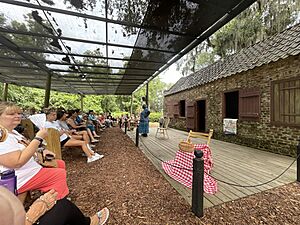
The brick slave quarters at Boone Hall are still standing today. They lasted a long time because they were built with strong materials. Many slave homes were made of wood. These were often removed from farms when owners did not want reminders of slavery.
The history of the enslaved workers at Boone Hall is explored in detail. This includes items found during archaeological digs around the houses. The history is also connected to Gullah culture. This culture is shared through living history presentations, including songs and stories.
The main house was built in 1936. At that time, slavery was illegal. So, the history of the main house is separate from the history of the slave quarters. Enslaved workers did cook and clean for the Boone and Horlbeck families in earlier times.
Plantation Weddings Discussion
Many old plantations that are open to the public also rent out their spaces for events, like weddings. Boone Hall Plantation offers different places on its property for these events. However, holding weddings at plantations has become a topic of discussion.
Some wedding planning websites have decided to stop promoting plantations. They do this out of respect for the people who were enslaved at these places. For example, actor Ryan Reynolds had his wedding at Boone Hall in 2012. He later said that he and his wife saw it as a wedding place at the time. But they later understood it was a place built on a very sad history. He said it was a big mistake and that it made him think differently.
Boone Hall Plantation has said that they value their relationships with couples who choose to get married there. They respond to concerns privately and honestly. They want to listen and focus on love and respect. They aim to be part of the solution for couples, not part of the problem.
Gallery
See also


